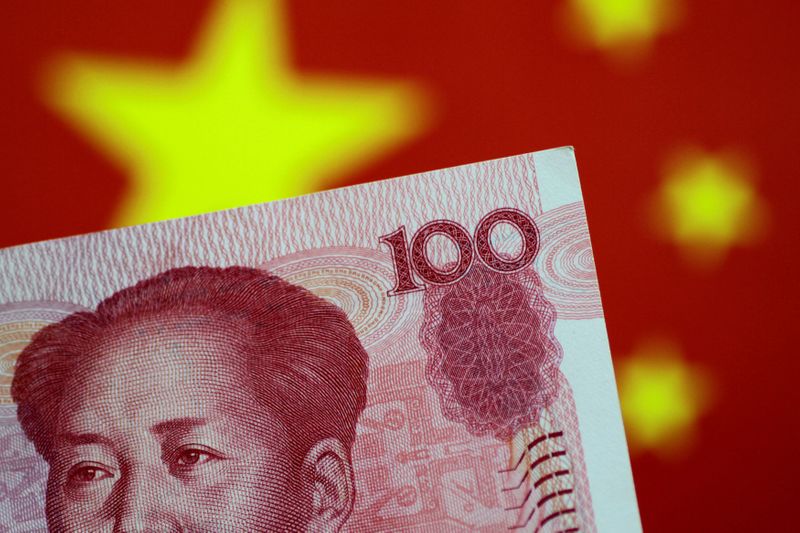SHANGHAI (Reuters) – China’s government bond yields fell sharply on Thursday after the State Council, the country’s cabinet, said authorities would use timely cuts in banks’ reserve requirement ratios (RRR) to support the economy.
While the cabinet said China would keep monetary policy stable, investors took talk of cuts in RRR – the mandatory reserves that banks have to set aside – as a strong easing signal.
China’s yuan currency reacted bearishly, weakening by as much as 0.17% to a near one-week low against the dollar.
One-year dollar/yuan swap points also dropped on expectations for shrinking yield spread between China and the United States, though some traders were perplexed that China was signalling easing, when the U.S. Federal Reserve was set to tighten next year.
And stocks fell as some investors started to worry about softening growth momentum in the rest of this year. [
Since its last targeted RRR cut in April last year at the height of the coronavirus pandemic, the People’s Bank of China (PBOC) has kept what it terms a neutral and prudent policy stance.
The most-traded contract for 10-year Chinese government bond (CGB) futures, for September delivery, jumped 0.41% in early trade on Thursday, while the yield on China’s benchmark 10-year government bonds fell to 3.037%, according to Refinitiv data, the lowest level since August 2020.
CGB futures have gained nearly 1.5% from mid-June lows after a slew of weaker-than-expected economic data prompted worries that China’s economy might have peaked and could require additional support.
The dovish comments from the cabinet still caught many traders and analysts off-guard.
Some market participants said the PBOC is unlikely to take a completely different monetary policy approach to its global peers, which are set to pare back stimulus.
“It doesn’t make sense to ease now before the Federal Reserve is set to tighten next year,” said a trader at a Chinese bank.
Lu Ting, chief China economist at Nomura, said the shift towards easier policy settings was unsurprising, but waving the RRR card had wrongfooted markets.
“A high-profile tool such as (an) RRR cut was a big surprise to markets and us,” said Lu.
“Beijing’s policy solutions to the surging raw material prices are in line with views that it will use policy easing instead of policy tightening to contain the rise of commodity prices,” he said, expecting the PBOC to deliver a 50 basis points of universal RRR cut in coming weeks.
Soaring commodity prices have driven China’s May producer prices to the fastest pace since the global financial crisis, while consumer inflation was rather stable and stayed below the annual target of 3%, suggesting the pass-through effect remained limited.
Some traders said the talk of an RRR cut would not necessarily turn into action. A previous cabinet meeting in June last year also mentioned using RRR cuts to support the economy, but no cuts materialised.
Meanwhile, central bank vice governor Fan Yifei told media on Thursday that China will continue to push real lending rates lower, and reduce financing costs for small companies through targeted monetary policy tools.
More targeted easing may be likely. Zhang Yu, chief analyst at Huachuang Securities, noted that the RRR cuts floated by the cabinet are meant to support smaller firms, which have continued to lag a broad economic recovery this year.
“Small and micro enterprises are now facing a triple squeeze — poor domestic demand, rising raw material prices on the supply side, and a marginal tax increase as a result of a waiver of reductions in social security fees,” she said.
(Reporting by Winni Zhou and Andrew Galbraith; Editing by Vidya Ranganathan, Richard Pullin & Simon Cameron-Moore)















